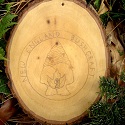I'm loving the little forge I made from a gas bottle and I learned an awful lot making it and modifying it. However, the stuff I'm making now means the actual forge itself is a bit small. I don't want anything too big as, until I get the new shed built (at which point the forge moves indoors and will be at least 2' by 2' purpose built!) I do all my smithing outside and need something portable so I've begun making another forge.
The design criteria were 1. must be as cheap as possible! 2. must use reclaimed materials where possible 3. must be able to get decent lengths of steel into it
Started by scrounging an old gas bottle off the scrap heap at work (15kg butane). This is a good size as it's wide so will allow a decent sized fire. Following the usual precautions (neck off the valve, leave upside down for a day, fill with water for a few days - probably overkill but I'm still alive and intact and I like it that way!) I set about cutting it in half lengthways. To do this, first I drained the water. This can take ages, but I drilled a 1/4" hole in the bottom of the bottle to let air in as the water came out and it was done in no time! I then made a shallow cradle from wood offcuts to hold the bottle still on its side and made a mark on a stick which corresponded with the half-way height of the bottle. Using the stick, I was able to make marks all round the bottle at the half-way height and join the dots to get a cutting line before breaking out the angle grinder and cutting in half. I use the very thin "stainless steel" cutting disks - they melt through all manner of steels in no time at all and they're cheap as chips from the local autojumble! I ended up with this:
Last night I set about making the tuyere (the pipe the air goes through to the fire pot). I still had some of that 2" square hollow section steel tube left over from the last forge build (reclaimed from an old glass cutting bench in a factory) so out came the grinder and welder. I founc that two lengths, about 8" long, were about right. I used the grinder to cut a square hole in the side of one tube, over which the second tube was welded.
The parts ready to weld
Tacked together, check everything is still in alignment before fully welding
All welded up!
Next step was to mark out the position of the corresponding hole in the bottle and cut it. I used a strip of paper to measure the distance round the half-bottle from one side to the other, then folded it in half to get the half way point. Here, I centrepunched the steel and used a hole saw to cut the hole. A few notes on holesaws and steel: The Aldi ones are very good so no need to spend a small fortune on Starrett, unless you want to! Steel can be very snatchy - set your drill to its lowest gearbox setting and if it has a speed control too, keep the speed low! And don't pish too hard - as I learnt at engineering college - the secret to steel is rock bottom speed, rock bottom feed! And use plenty of oil, it'll prolong the life of your holesaw, make the job easier and reduce snatching. WD40, 3-in-1, Rocol, 151 superspray, good old fashioned White Water, any of them will do, just don't be shy with it!
the centrepunched position and the hole saw - Aldi's best!
The finished hole!
Last job was to weld the tuyere assembly to the bottle over the hole. First job, clean all the oil off! Cotton rag and degreaser here (or, if you're a yorkshire lad like me, an old pair of pants and the wifes nail varnish remover! Shhhh! Don't tell her!) Next, remove the paint from the surrounding area on both bits of metal and chamfer the edges slightly on the tuyere. Cleanliness is next to Godliness when it comes to welding! I had to dress the edges of the tuyere to make a good fit to the bottle as the bottle is curved and there was also a weld line around the bottle. Once you have a good fit, tack it together with a few spots of weld, you can then check the alignment and adjust it if needs be. Once you're happy, pour in the amps and get it all welded up and it should end up looking something like this!
and from the inside:
Quite pleased with this for a nights work! Got some old table legs from a "tasteful" table my folks got back in the 80's which will form the stand and a bit lump of steel to make a baffle off the back hitch of a tractor, but thats for another time! Total material cost so far - Nowt!
Wassail!
Phil














 Reply With Quote
Reply With Quote



























